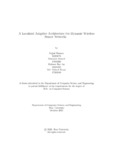| dc.contributor.advisor | Chakrabarty, Amitabha | |
| dc.contributor.author | Hussain, Sajjd | |
| dc.contributor.author | Ahmed, Muntasir | |
| dc.contributor.author | Joy, Kishanu Roy | |
| dc.contributor.author | Hasan, Md. Mehedi | |
| dc.date.accessioned | 2021-12-09T09:52:20Z | |
| dc.date.available | 2021-12-09T09:52:20Z | |
| dc.date.copyright | 2020 | |
| dc.date.issued | 2020-10 | |
| dc.identifier.other | ID 16201075 | |
| dc.identifier.other | ID 17101190 | |
| dc.identifier.other | ID 18101190 | |
| dc.identifier.other | ID 17201149 | |
| dc.identifier.uri | http://hdl.handle.net/10361/15717 | |
| dc.description | This thesis is submitted in partial fulfillment of the requirements for the degree of Bachelor of Science in Computer Science and Engineering, 2020. | en_US |
| dc.description | Cataloged from PDF version of thesis. | |
| dc.description | Includes bibliographical references (pages 35-36). | |
| dc.description.abstract | IoT is seen as the next big thing in the world to come. Previously people were less
connected with the internet. But in recent years, IoT has seen substantial research
and innovation in many technology areas, and uses of the internet are increasing
day by day. In the near foreseeable future, the vast number of devices connected
together will result in highly complex networks that would cause an exponential
increase in computation times, latency and power consumption. In this paper, we
take a modular approach to dealing with the issue. We propose a Weight-based
Adaptive Neighbor Localization (WANLoc) Algorithm that creates a highly opti-
mized network based on localized network architecture that is network independent.
This means that the sensor nodes in this network do not need to communicate with
any cluster head or sink in order to function. In addition, WANLoc is intended
to function in a dynamic wireless sensor network where nodes enter and exit the
network regularly. This also means that it is exceptionally good at handling node
failures. Nodes in this network only communicate with their immediate neighbors,
maintained in a set of dynamic tables designed to reduce lookup times when deciding
whom to forward data to. This also means that nodes can now be configured with
minimum transmission capabilities, saving a lot of precious energy in the process. | en_US |
| dc.description.statementofresponsibility | Sajjd Hussain | |
| dc.description.statementofresponsibility | Muntasir Ahmed | |
| dc.description.statementofresponsibility | Kishanu Roy Joy | |
| dc.description.statementofresponsibility | Md. Mehedi Hasan | |
| dc.format.extent | 36 pages | |
| dc.language.iso | en | en_US |
| dc.publisher | Brac University | en_US |
| dc.rights | Brac University theses are protected by copyright. They may be viewed from this source for any purpose, but reproduction or distribution in any format is prohibited without written permission. | |
| dc.subject | WANLoc | en_US |
| dc.subject | Wireless sensor networks | en_US |
| dc.subject | Self-Adaptive | en_US |
| dc.subject | Internet of Things | en_US |
| dc.subject | Network architecture | en_US |
| dc.subject | Routing algorithm | en_US |
| dc.subject | Network topology | en_US |
| dc.title | A localized adaptive architecture for dynamic wireless sensor networks | en_US |
| dc.type | Thesis | en_US |
| dc.contributor.department | Department of Computer Science and Engineering, Brac University | |
| dc.description.degree | B. Computer Science | |

